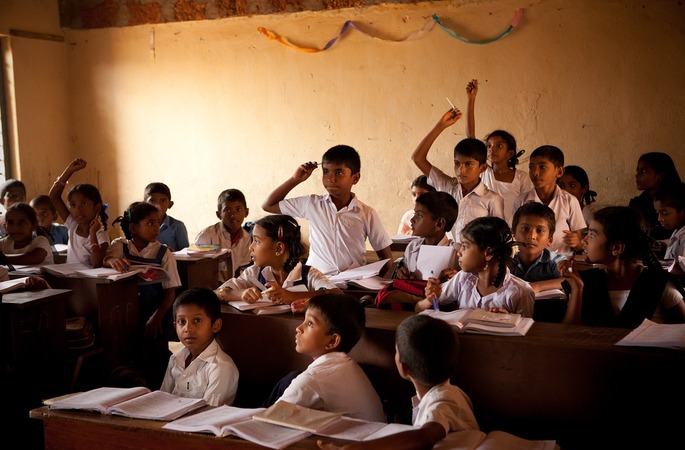People who criticise teachers tend to overlook the fact that the typical government school teacher has a challenging situation – a shifting population of children who are at different levels, with home conditions that do not always support education, and with having to simultaneously handle more than one language and more than one class
Naturally, teachers end up finding much of the advice given to them is merely a pile of someone else’s unrealistic expectations, which they have to try to live up to under impossible circumstances.
To my mind, therefore, the question ‘What is a good classroom?’ Is closely linked with what is possible, and not just what is desirable. When teachers find that a good classroom is possible, more and more of them will try to improve their classrooms, and they will see it is much more fun and more satisfying.
What Is A Classroom
During a discussion on the future of a foreign-funded project, on whether funding should continue or not, and what would happen to the schools if it did not, a teacher said: “Nothing! Nothing will happen to the school merely because the foreign funding stops.
It is a mistake to think that a school is its building, and books and doors and windows. People can come and remove the doors or break the building, but nobody can touch the real thing – that is, what happens between my children and me!”
Thus a classroom is indeed a learning situation, the physical aspect of which, though necessary in its own way, is not as crucial as the emotional, intellectual, social and cultural one. A classroom is substantially defined by the nature of interaction among its participants, the children and the teachers, and occasionally others as well. The physical aspect might help, but will not entirely determine this interaction.
Work Less!
Some years ago, I visited a model school that was implementing what was considered to be ‘activity-based teaching’. A teacher from this school complained that such teaching was very, very tiring! By observing his classroom, I found out that the teacher himself was doing all the singing, action, and so on, while the children sat and watched! Naturally, it was very tiring!
In many ways, even in the traditional classroom, this is what we end up doing much of the time. We think out everything for the child, provide all the answers, spoon feed the children and believe that we are very hard working! Often, even if something is already known to children, we teach the same thing over again without bothering to find out whether children can do it on their own or not.
So the first step in creating a good classroom is: work less! Avoid doing for children what they should be doing for themselves. See yourself as a facilitator, rather than a dispenser of knowledge. Make use of their previous experience and understanding. Create room for students to arrive at their own understanding. Instead of wasting time on issues already known to them.identify areas where they need support, and concentrate on them.
Create Tasks And Beginnings
How can you get around to working less? By finding interesting tasks, which children would like to work upon on their own, leaving you free to offer support where it is needed.
Children are naturally more active than passive. They love challenges and working on situations that move from one point to another (e.g. games, or making things, or enacting something, or solving a problem). They also find it fun to work with each other and help each other. Make use of these tendencies to create interesting tasks and support them as they complete these tasks.
In all this, your role really is that of identifying tasks or activities that:
- Students will find interesting and challenge (that is, the tasks will be possible, but not too easy for their level),
- Have a purpose for them (which may be different from the goal they have for you!),
- Are related to curricular objectives you are focusing.
Once you have presented the task, children start on them, and you offer help only where it is needed.
Finally, once the tasks are over, your role is that of enabling reflection on what has just been experienced, to consolidate it regarding learning. Thus children are not learning by memorising, but by thinking on their own, and coming to their own understanding.
As you can see, a good classroom is very different from one where the teacher is doing the talking and pushing and driving much of the time. It is infinitely more relaxing to create interesting tasks and watch students do them, with minimum help from you. All this, of course, does not happen in one go. You have to start carefully, with what can actually be done, before moving on into a situation where your class has children working on their own for a great part of the time.
Don’t Allow Yourself To Get Bored
Even the most interesting tasks, repeatedly done, begin to wear out and soon stop being interesting. And the loss of interest on the learners’ part results in loss of learning. So what is being suggested is not merely doing a few interesting tasks over and again. There is a need to build variety in what is being done. In the absence of variety, learning suffers.
A new activity might need to be repeated in more or less the same manner in the beginning. But very soon, variations in it will be required. In fact, it is effortless to make an activity easier or more difficult depending on the level, background and interests of children, something that is not always possible with the typical textbook-based lesson.
As you can see, whether a class session lasts 40 minutes or a whole day, there can be sufficient variety across the period, enabling children to retain their interest. At the same time, since all children do not necessarily learn in the same way, this variety allows for all children to find a means suited to their particular style of learning.
What all this implies is that the old system – of teaching the whole class, in the same way, the entire time with the same material – is not very appropriate. In an activity-oriented classroom, it should be possible to offer variety, and even for different children (say in different groups) doing what is suitable for them. Such self-learning phases during a day or session provide the teacher with an opportunity to help those children who might need such help more.
Discover How Rich You Are!
Make a list of all those things that can be found in or around your school: Eg benches, polythene bags, seeds, sticks, pebbles, charts, leaves, sand, old calendars, strings, and countless other things. You’ll find that most of them can serve as learning material for something you might want to teach. For example leaves help in classification and mathematical operations, sticks in seriation and spatial skills and so on. The best part is that they are all free, and you don’t even have to make an effort to get them yourself – asking children to collect such material is part of the learning process.
Also, there are plenty of things you and children can make together, which can be used for a variety of learning purposes. For example masks, clay toys, picture charts, flash cards of all kinds and so on.
Finally, many of you will be lucky enough to have material that has been supplied (e.g. kits for science or mathematics, or library books, etc.) or even to be given a certain amount of money for the purchase of materials. Earlier, teachers used to be worried that if any material is spoilt, they would have to pay for it, and this resulted in all this material being kept in cupboards or trunks. But now, authorities have realised that material is actually to be used! Hence, torn books or weathered material is no longer considered disastrous. Use it as well and as much as you would like to.
In an interaction with such material, children learn through the use of their sensory organs and the dynamic manipulation of material from one state to another, as in arranging or making a model or solving a problem and the like.
Thus it is no longer accurate to say that there is a shortage of material, and in a good classroom, one would expect to see plenty of it – in children’s hands rather than displayed on the wall!
Get Children To Run The Class.
Very effective teachers look upon children as team members who play a role in running the class, rather than as a ‘herd to be managed’. One critical assumption here is that once children have purposeful tasks to do, they do not need ‘discipline’ (you have to try this out before doubting this statement!).
In an atmosphere of freedom where children can talk, ask questions, and collaborate in completing a task, it is usual to find that they are able to make decisions, handle responsibility, and are eager to support the teacher in as many ways as possible.
This includes handling material collection, distribution and storage; helping other children if needed, and maintaining discipline on their own.
This last is facilitated best if the whole class (that is, teachers and children together) make commonly agreed-upon ground rules for functioning, including deciding upon the consequences of violating them. In such a situation it is common to find that children rarely need to be made to do something. Instead, they come on their own to find out what they should do.
Of course, the difficulty arises when the teachers themselves violate the agreed-upon ground rules. If they willingly accept the consequences, they send a strong message of equality and participation to their children, and discipline is really no problem.
In a good classroom, therefore, we would expect to see everyone working as a group, having both a say and a responsibility too.
Plan A Lesson Like A Meal
Naturally, such a classroom will not come about on its own. It needs to be planned. Again, you’ll find many people saying that teachers cannot really plan. And, once again, this is something that is not true. With your classroom, you would need to start by finding out where the children already are, where you think they should get to in the time available, what you have to do, and the sequence in which you have to do it, and so on.
To use an everyday analogy, to do a good job while a meal is cooked you keep checking from time to time whether things are OK or not, whether you have added the salt, or whether it is cooked sufficiently. This is what ongoing evaluation is like – you keep an eye on whether learning is going in the right direction or not.
Similarly, it is crucial to ensure that you make sure things are available where they should be, that time is not wasted, and all the resources you have are well utilised. This is what, in the specialist language of academic educationists, is called ‘management’ or ‘classroom organisation’.
When acting as a host, you do your best to put your guests feel at home. In classroom terms, this would be called creating a ‘welcoming atmosphere’ and is one of the key enabling factors that help to learn.
And Finally
What this article assumes is that the teacher is not an empty vessel who should be told what to do. Instead, the teacher here is regarded as a partner with whom the basic principles need to be shared, and agreed on, based on which she or he will find her or his own solutions in their specific situation. And the key question that needs to be addressed is that of hosting children, and of doing one’s best to ensure that they learn actively in an encouraging atmosphere.
Can it be done?
Are we ready?



